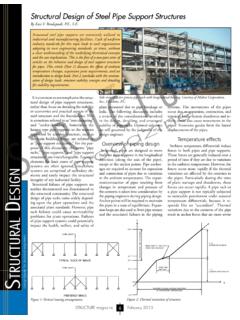Transcription of AAMA DISTANCE EDUCATION Specifying …
1 Performance-based standards for windows and doorsrate completely fabricated products according to how theyperform under actual job site conditions rather thanattempting to prescribe detailed physical attributes suchas framing member thickness, assembly details, etc. Theythereby provide a uniform basis for comparing key perform-ance attributes of different manufacturers' windows of thesame type, class and grade for a given application, therebytaking into account the unique properties and comparativestrengths and weaknesses of all profile materials. For win-dows and doors, these essential performance characteristicsare structural performance under wind loading and thelevel of resistance to air leakage, water penetration andforced entry. From this platform, currently represented bythe aama /WDMA/CSA 101 2/A440-05 standard, otherperformance requirements for specific window types ( ,casement, horizontal sliding, etc.), as well as for optionalenergy efficiency attributes ( , thermal performanceand condensation resistance), can be referenced to meetspecific markets or job criteria.
2 The specifier or product designer determines the levelof performance desired under defined conditions. Then,factoring the well-understood characteristics of the materialand components into the equation, the manufacturer buildsa window that meets the specified performance level. In gen-eral, the required performance drives the product s DISTANCE EDUCATIONS pecifying Windows and Doors Using Performance StandardsThis program is registered with the AIA/CES for continuing professional EDUCATION . As such, it does not includecontent that may be deemed or construed to be an approval or endorsement by the AIA of any material of construction or any method or manner of handling, using, distributing, or dealing in any material or related to specific materials, methods, and services will be addressed at your Metal Window Institute (NFMWI formed)1947 First Guide Specification for double-hung aluminum windows published; NFMWI becomes Aluminum Window Manufacturers Association (AWMA)1960 Hurricane Window performance level is introduced1950 Introduction of performance groups: A1 for residential and A2 for architectural applications1983 American Architectural Manufacturers Association formed.
3 Now encompasses aluminum and vinyl windows and doors, stormwindows, curtain wall, storefront, skylights, manufactured housing1985101-85 standard earns ANSI-accreditation, encompasses 13 operator types and introducesR, C and HC performance classes1988 101-88 introduced as first material-neutral, performance oriented windowstandard (aluminum and vinyl products);1503 and 1504 thermal performance standards introduced1962 aama Certification Program is launched; Architectural Aluminum Manufacturers Association ( aama ) formed from merger of AWMA andSliding Glass Door & WindowInstitute1972 aama Certification Programbecomes ANSI-accredited1993 AWperformance class introduced1997 aama /NWWDA 101 2-97 standard introduced (adds wood products)2005 aama /WDMA/CSA101 2/A440-05 standard introduced as firstever to harmonize and Canadian performance requirements ; includes windows, sliding glass doors, skylights and entry doorsHow Window Standards Have EvolvedThe evolution of window standards traces an increasingly sophisticated approach to window design and an evolvingunderstanding of the factors influencing window performance, as well as increasingly more stringent performancerequirements in response to the demands of architects and specifiers.
4 These efforts have culminated in combined, material-neutral, performance-oriented guidelines for excellence in the design and fabrication of window and door products that recognize their important role in today s complex building systems. It is the buyer s task to first determine the tradeoffbetween performance level and cost that is acceptable forthe job at hand. Given equal performance requirements , thechoice of framing material (aluminum, fiberglass, vinyl,wood, etc.) basically reduces to one of preference withregard to operating features, appearance, economics, etc.,rather than determining which material is better thananother at some absolute level. Because performance-based standards effectively eliminate the basis for compet-itive argument as to which fenestration framing materialperforms the best, they are said to be material-neutral. Like its predecessors, aama /WDMA/CSA 101 encompasses all framing materials, offering abasis for comparing the key characteristics and qualityattributes of all window and door materials and productsfor the same market applications from a material-neutralpoint of view.
5 It also serves as the cornerstone for an inter-locking system of third-party product performance certifi-cation and component-level quality control to establish auniquely credible total quality management system formanufacturers as well as a reliable Specifying mechanismfor architects. The International Residential Code (IRC)and International Building Code (IBC) both currently reference the 2005 standard. Both of its predecessors from1997 and 2002 were previously recognized. All three mayserve as the basis for third-party certification, althoughearlier versions will eventually be phased it is the foundation of today s state-of-the-artperformance standards, the 2005 standard and its require-ments serve as the basis for this Window Do You Want?The first step is to select a product operator type, indicated by a letter code. There are 30 distinct product types identified in the 2005 standard, as shown in the following table.
6 aama /WDMA/CSA 101 2/A440-05 Product Type Designation SystemTYPE CODEWINDOW OR GLASS DOOR TYPETYPE CODEWINDOW OR GLASS DOOR TYPES liding Seal Window ProductsSpecialty Window ProductsHSingle/Double/Triple HungBWBasement WindowHSHorizontal SlidingHEHinged Egress (rescue window)VSVertical SlidingGHGreenhouseCompression Seal Window ProductsJJalousieAPAwning, Hopper or ProjectedJAJal-AwningCCasementTATropical AwningVPVertically PivotedTRTransomHPHorizontally PivotedSPSpecialty Products*SHWSide-Hinged InswingingDoor ProductsTHTop-HingedAT DArchitectural Terrace DoorFixed Window ProductsFDFixed DoorFWFixedSHDSide-Hinged DoorUnit Skylight ProductsLW SHDL imited Water Side-Hinged DoorSKGS kylights/Glass GlazedSLTSide liteSKPS kylights/Plastic GlazedSDSliding DoorRWRoof WindowDASHDDual Action Side Hinged DoorDual Action Window ProductsLWDASHDL imited Water Dual ActionSide-Hinged DoorDAWDual Action Window(NOTE: The products in blueare new or revised in the 2005 standard.)
7 * TheSpecialty Products category was established to clarify how performance is to be measured for size and shape variations of other product types ( , half-rounds, trapezoids and other configurations) and is congruent with current NFRC terminology. Note that this does not replace the Specialty Window Products grouping defined in the 1997 standard, where the existing categories for basement, greenhouse, jalousie, etc. windows are still Building?Once the type of window is decided upon ( , double hung, casement, slider, etc.), the next step is to define the kind of structural environment in which the window is to be installed. The 2005 standard helps by defining a productnomenclature and Performance Designation System. These designations can be quickly and easily used to specify example of a complete four-part product designator for a horizontal sliding window would thus look like:3 PRODUCT KEYA= Product Type: Horizontal Sliding Window (HS)B= Performance Class: RC= Performance Grade: Design Pressure = 15 psfD= Maximum Size Tested: Width x Height (63x44)HS - R15 63x44 Product Designation SystemABCDLet s take closer look at the elements of this designatorand how it provides essential information on its perform-ance.
8 The four parts include:nProduct Type (operator type per the previous table)nPerformance ClassnPerformance GradenMaximum Size Tested Performance ClassThe second part of the product designator is thePerformance Class. The 2005 standard recognizes fivePerformance Classes, each of which addresses the needsof a particular market segment by requiring increasinglystringent basic performance requirements :R = typically one- and two-family structuresLC = typically low-rise multi-family, offices, motels, professional buildingsC=typically light industrial, hotels, retail buildingsHC = typically mid-rise hospitals, schools, governmentbuildingsAW= typically larger institutional or high-rise buildings,or demanding usage situationsPerformance Grade The third element of the product designator is thePerformance Grade, the key to Class designation. Entryinto each Performance Class is keyed to a minimum (or gateway ) Performance Grade, which is equal to theDesign Pressure (wind load) at which the products havebeen tested, expressed in Pascals (Pa) in the metric system,and in pounds per square foot (psf) in the IP system.
9 Agiven design pressure corresponds to a wind velocity asthe table below is a good time to note that, unlike its predecessors,metric units are the primary measurement system in the2005 standard, with inch-pounds (IP) units secondaryand shown in parentheses after the metric units, as theMinimum Design Pressures shown below. While this articlewill be presented hereafter in terms of IP units, given its primarily American audience, the IP figures must beconsidered approximate as conversions are not metric requirements must be met when products aretested for conformance to the PerformanceClassMinimum PerformanceGradeMinimum DesignPressureEquivalentWind Speed (mph)R15720 Pa (15 psf)77LC251200 Pa (25 psf)100C301440 Pa (30 psf)109HC401920 Pa (40 psf)126AW401920 Pa (40 psf)126 Note: Wind speeds indicated are not to be used for building code Performance Level Do I Need?The 2005 standard defines fourmandatory performance require-ments within each PerformanceClass for a completely fabricatedwindow:nStructural adequacy to withstandwind loads at the design pressurenResistance to water penetrationdue to wind-driven rainnResistance to air infiltrationnForced entry resistance (FER)4 Map reprinted with permission of RoofHeight (ft.)
10 Positive PressureAll AreasNegative PressureArea 4 Area 5 BASIC WIND SPEED - 70 WIND SPEED - 80 1: DESIGN WIND LOAD TABLES (psf)Thefirst two of these arguably the most important for awindow s functioning as a structural element are keyed tothe Design Pressure (Performance Grade) for the buildingsite. The Design Pressure is a result of wind loading thatis, the force of wind blowing against the installed penetration is dependent upon the wind pressurebehind rain that strikes the window. So, the first order ofbusiness must be to determine the wind conditions towhich the window will be classic 2005 standard reference for determiningdesign wind load is ASCE 7-02, "Minimum Design Loadsfor Buildings and Other Structures."The design wind speed for the building s location (typically a maximum likely to be experienced at that site)is determined by reference to the following wind speedmap from ASCE-7-02*.Once the height of the building is known, the DesignPressure can be determined from the second column ofASCE-7-02* Table 1, a portion of which is excerpted forillustrative purposes from ASCE-7-02 and aama TIR A10, Wind Loads on Components and Cladding for Buildingsless than 90 Feet Tall, which also includes more completeinformation on all four versions of ASCE-7-02*.




